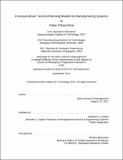| dc.contributor.advisor | Stephen C. Graves. | en_US |
| dc.contributor.author | Chhaochhria, Pallav | en_US |
| dc.contributor.other | Massachusetts Institute of Technology. Operations Research Center. | en_US |
| dc.date.accessioned | 2012-01-30T15:22:16Z | |
| dc.date.available | 2012-01-30T15:22:16Z | |
| dc.date.copyright | 2011 | en_US |
| dc.date.issued | 2011 | en_US |
| dc.identifier.uri | http://hdl.handle.net/1721.1/68700 | |
| dc.description | Thesis (Ph. D.)--Massachusetts Institute of Technology, Sloan School of Management, Operations Research Center, 2011. | en_US |
| dc.description | This electronic version was submitted by the student author. The certified thesis is available in the Institute Archives and Special Collections. | en_US |
| dc.description | Cataloged from student submitted PDF version of thesis. | en_US |
| dc.description | Includes bibliographical references (p. 243-247). | en_US |
| dc.description.abstract | Our work is motivated by real-world planning challenges faced by a manufacturer of industrial products. In the first part of the thesis, we study a multi-product serial-flow production line that operates in a low-volume, long lead-time environment. The objective is to minimize variable operating costs, in the face of forecast uncertainty, raw material arrival uncertainty and in-process failure. We develop a dynamic-programming-based tactical model to capture the key uncertainties and trade-offs, and to determine the minimum-cost operating tactics. The tactics include smoothing production to reduce production-related costs, and segmenting the serial-flow line with decoupling buffers to protect against variance propagation. For each segment, we specify a work release policy and a production control policy to manage the work-in-process inventory within the segment and to maintain the inventory targets in the downstream buffer. We also optimize the raw material ordering policy with fixed ordering times, long lead-times and staggered deliveries. In the second part of the thesis, we examine a multi-product assembly system that operates in a high-volume, short lead- time environment. The operating tactics used here include determining a fixed-length cyclic schedule to control production, in addition to smoothing production and segmenting the system with decoupling buffers. We develop another dynamic-programming-based tactical model that determines optimal policies for production planning and scheduling, inventory, and raw material ordering; these policies minimize the operating cost for the system in the face of forecast and raw material arrival uncertainty. We tested these models on both hypothetical and actual factory scenarios. The results confirmed our intuition and also helped develop new managerial insights on the application of these operating tactics. Moreover, the tactical model's factory performance predictions were found to be within 10% of simulation results for the testbed systems, thus validating the models. | en_US |
| dc.description.statementofresponsibility | by Pallav Chhaochhria. | en_US |
| dc.format.extent | 247 p. | en_US |
| dc.language.iso | eng | en_US |
| dc.publisher | Massachusetts Institute of Technology | en_US |
| dc.rights | M.I.T. theses are protected by
copyright. They may be viewed from this source for any purpose, but
reproduction or distribution in any format is prohibited without written
permission. See provided URL for inquiries about permission. | en_US |
| dc.rights.uri | http://dspace.mit.edu/handle/1721.1/7582 | en_US |
| dc.subject | Operations Research Center. | en_US |
| dc.title | Forecast-driven tactical planning models for manufacturing systems | en_US |
| dc.type | Thesis | en_US |
| dc.description.degree | Ph.D. | en_US |
| dc.contributor.department | Massachusetts Institute of Technology. Operations Research Center | |
| dc.contributor.department | Sloan School of Management | |
| dc.identifier.oclc | 773934118 | en_US |
